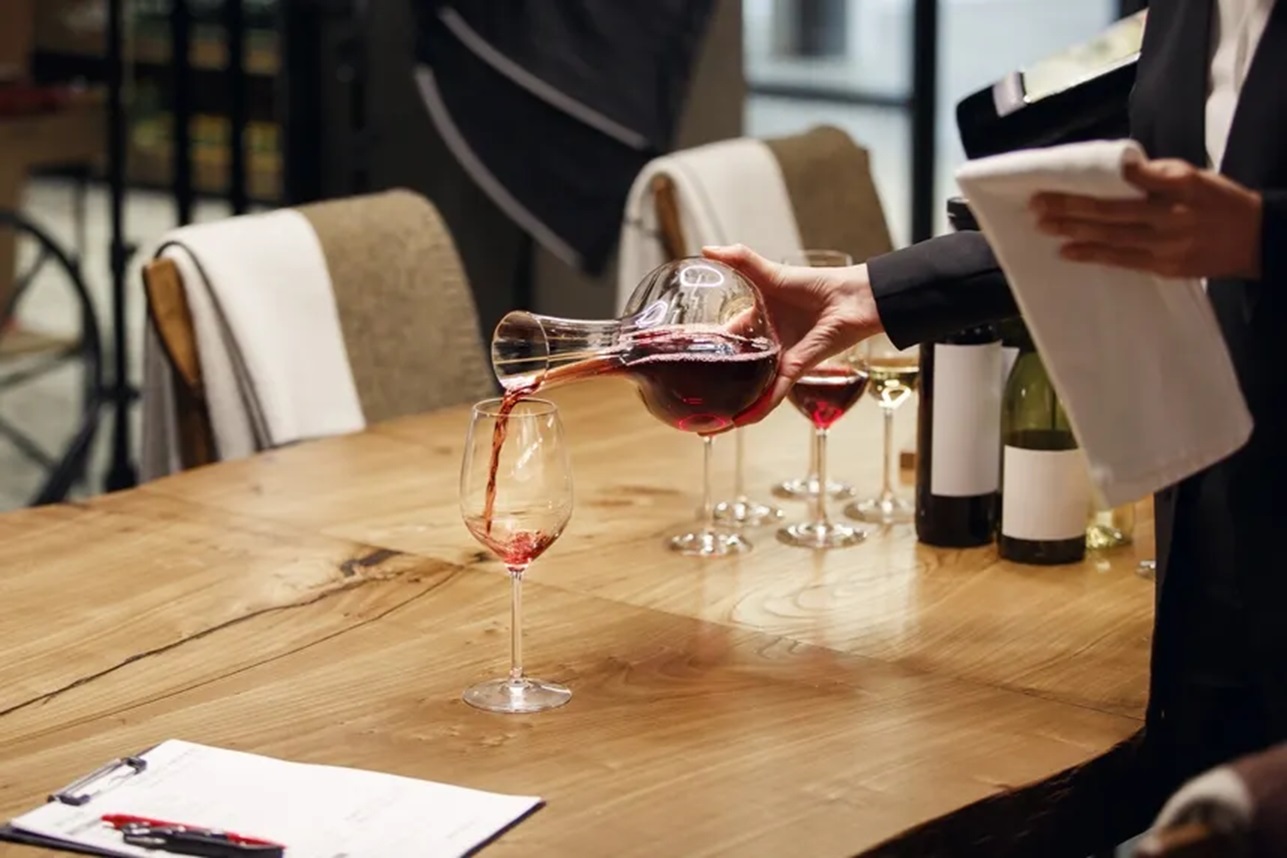Structure, body, straightforwardness, perlage... chances are that at least once in your life you have heard these words coming out of the mouth of a sommelier, whether during a guided tasting in a cellar or on a television programme. This profession, however, is not only based on the use of obsolete technical terms, but is founded on a great passion for wine and an in-depth knowledge of the sector - matured after years of study - that allow this figure to narrate a label as if it were the most splendid of poems.
Do you want to know what a sommelier does and what is the path to become one? Giordano Vini explains it to you in this guide!
Not just a 'wine taster': what is a sommelier?
Among the first images that form in the mind when one speaks of a sommelier is that of an expert wine taster, who brings his goblet close to his nose and then describes the characteristics of the product in detail. In reality, this profession is much more complex and multifaceted than that.
While a wine taster is in charge of tasting the product and providing a precise technical judgement, the sommelier's task is to offer a more in-depth overview, recounting its history, terroir, and grape variety of origin, touching on topics such as serving temperature and food pairings.
One could therefore say that within the many environments in which he or she works - such as catering, hospitality, journalism, training and events - the sommelier is an all-round wine (and other) expert, with tasks ranging from the selection of suppliers to the purchase of wines, from the management of the cellar to the updating of the wine list, from staff training to consultancy, obviously dealing with the tasting and presentation of wines, the choice of glasses and advice on wine pairings. To accompany a nice fiorentina steak or a Tuscan ribollita, for example, he could propose a 'Selvato' Chianti DOCG, with persuasive notes of ripe fruit and violets.
Tasting in brief: the sommelier's role in describing a wine

Among the many skills of the sommelier, the one that is most emphasised in contact with the public is the ability to taste a wine and to describe it in detail, not only in terms of its production history, but also as a product capable of having a strong sensory and emotional impact on the consumer.
Without going into too much detail, it is worth touching on this aspect, in order to get to the heart of what the career of a sommelier entails once he is in front of a bottle of wine.
The sommelier opens the tasting by choosing the right glass, respecting the serving temperature of each different variety of wine and presenting the product in a context that is as free of interference as possible, both auditory and olfactory.
It then proceeds with:
- Visual examination: through which it assesses clarity, looking for any suspended particles, as well as transparency and intensity of colour, by observing the wine against a white background. In the case of sparkling will also observe the perlage
Finally, visual examination also reveals thefluidity of the liquid, which can be seen by rotating the wine in the goblet and observing the speed with which it flows over the surfaces (forming so-called arches).
- Olfactory examination: by bringing the slightly tilted goblet close to the nose, take a few small breaths, to assess firstly the intensity of the aromas and their integrity, i.e. the absence of defects. He can also understand the degree of complexity - i.e. the variety of aromas that characterise it - and the nature of thesestarting with floral aromas, then moving on to fruity, herbaceous and finally all the others
A sommelier may for example describe a Barolo DOCG, an excellent Piedmontese red wine, as complex and full-bodied, in which fruity aromas of morello cherry prevail, with a vanilla finish.
- Gustative examination: by taking small sips and running the wine over the surface of the tongue - which is responsible for the reception of flavours - it is possible to perceive the sensations in the mouth, such as structure, alcohol content, flavour, acidity and the presence of tannins, in the case of reds, as well as retronasal and aftertaste sensations. It is precisely at this moment that the sommelier can describe to the audience or diners the almondy - i.e. slightly bitter - finish of a 'Selvato' Vermentino Toscana IGT.
- Pairing tips: A wine tends to be paired with a dish either by association (e.g. a wine with a soft flavour goes well with dishes with a slightly sweetish aftertaste, while a full-bodied, intense wine goes well with an equally strong dish) or by contrast. A warm wine with a slightly vanilla finish such as an organic Chardonnay Puglia IGP goes well with the sweetish aftertaste of shellfish as well as with vegetable dishes.
Experts are not born: how to become a sommelier
As mentioned above, the sommelier profession does not only belong to the restaurant industry, but to a number of fields that have to do in various ways with the wine world. So if you want to pursue this profession through a targeted course of study, your professional future could lead you into one of these contexts:
- Catering
- Reception
- Commercial activity (running a wine shop or wine bar)
- Import and Export
- Private events (wine and food tours and cellar tastings)
- Consultancy
- Marketing
- Journalism and wine criticism
- Activities in cellars or wineries
- Training
Working in the wine sector - with its many facets - is an ambitious goal, which can only be achieved through much study and commitment, and the attainment of a sommelier diploma, issued by accredited bodies such as AIS (Associazione Italiana Sommelier), ASPI (Associazione Sommellerie Professionale Italiana), FISAR (Federazione Italiana Sommelier, Albergatori e Ristoratori), FIS (Fondazione Italiana Sommelier) and ONAV (Organizzazione Nazionale Assaggiatori Vino).
Sommelier courses are usually divided into 3 levels:
- Technical aspects: a level dedicated to viticulture and winemaking techniques, as well as specific aspects of tasting.
- Italian and foreign wines: with insights into grape varieties and terroirs.
- Pairings: dedicated to pairing rules, association techniques and other practical advice.
However, obtaining a diploma is not the end of the line for this professional, who must be able to delve into the world of wine in all its aspects, even after finishing his studies. Since the market is evolving rapidly, the training of an expert sommelier continues over the years through constant updates.
All this guarantees him a stable and renowned position, although in Italy the salary of a sommelier is lower than abroad. The monthly average is around 1,600-1,700€ gross, although in some cases it exceeds 3,000€ thanks to private events, consultancy, training other extras.
Now that you understand what a sommelier does, it's time to try your hand at some wine tasting. Explore Giordano Vini's wide selection, to find the right bottle for you (as well as the essential accessories for this figure)!
 Free Delivery from 69£
Free Delivery from 69£
